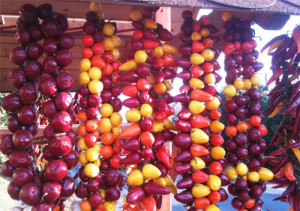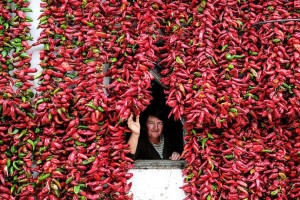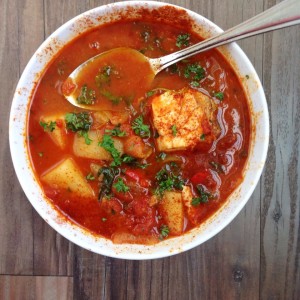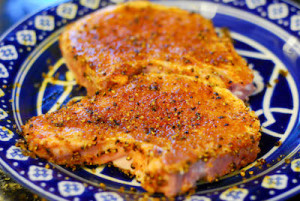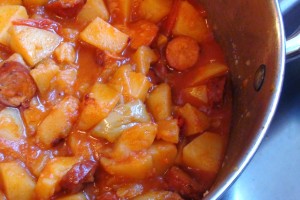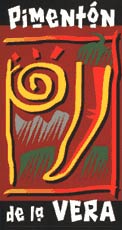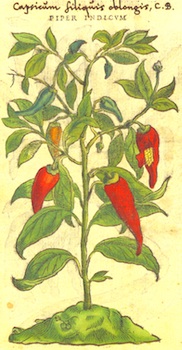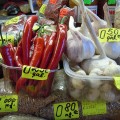By Sharon Hudgins
Recipes:
Paprika Fish Soup
Paprika Pork Chops
Paprika Potatoes
Csírkepaprikás (Paprika Chicken)
Green Beans with Paprika
Paprika Mushrooms
You can smell the stuff when you pull into town. The plants are ripe for picking, and a pungent aroma from the processing factories fills the air. It’s such an important cash crop that the locals even call it “Red Gold.” No, I’m not talking about some kind of controlled substance, the possession of which might land you in jail. This perfectly legal powder is paprika, the spice that’s almost synonymous with Hungary, where it’s produced.
A dozen years after my first trip to the little Hungarian town of Kalocsa, I returned once again, just in time for the annual pepper harvest in September. For three to four weeks every autumn, more than 8,000 acres of fields around Kalocsa are filled with farm workers picking bright red peppers and stacking them in small wooden crates or big plastic mesh bags. In the town itself, strings of shiny red peppers hang from balconies, porches, and eaves, like colorful ribbons on a peasant girl’s costume. And on some of the houses, long cylindrical mesh bags full of peppers are suspended from the eaves like giant sausages.
After being picked, the peppers are left to “rest” for two to three weeks, to let their flavor and color develop even further. Then they’re washed, dried, and ground into paprika, the red spice essential to Hungarian cuisine.
During September the entire town, its population swelled by busloads of tourists, celebrates the pepper harvest with a Paprika Festival. Called “Kalocsa Paprika Days,” it features exhibitions of food products, a professional conference on the topic of paprika, a variety of sports competitions, and a fish soup cooking contest (with paprika as a necessary ingredient, of course). The highlight of the festival is the Paprika Harvest Parade, complete with local bands and colorful folk-dancing groups, followed that evening by a Paprika Harvest Ball.
Regardless of the time of year, however, the visitor is never far removed from paprika in Kalocsa. In addition to its pepper fields and commercial paprika factories, Kalocsa has a Paprika Street and a Paprika Museum. Strings of dried peppers festoon store windows and roadside stands. Souvenir shops are filled with folk-art gifts adorned with images of bright red peppers, including hand-painted eggs, decorated dishware, and embroidered linens. And walls of houses and restaurants are painted with murals depicting traditional floral motifs, often with red peppers incorporated into the design. Compared to when I first visited Kalocsa several years ago, the sleepy little town that had been primarily an agricultural center has turned into a tourist mecca, especially at harvest time, attracting travelers from all over Europe and beyond.
Paprika Past
Although many Hungarian dishes use paprika as an ingredient, this colorful, flavorful spice is actually a relative newcomer to Hungarian cuisine. Pepper cultivation was established in Hungary during the Turkish occupation of that country in the sixteenth and seventeenth centuries—but it wasn’t until the late eighteenth century that paprika gained widespread acceptance as a spice in Hungarian foods. Formerly found only in peasant dishes, it gradually entered the culinary repertoire of the gentry and the nobility—dispersing throughout all levels of society so thoroughly that today it would be hard to imagine Hungarian cooking without its paprika component.
Kalocsa’s small Paprika Museum documents the history and techniques of paprika production in Hungary, from its beginnings to the present. Exhibits include historic photographs, antique paprika spice containers, and old stock certificates from paprika companies. Diagrams and models explain past and present methods of cultivating peppers, as well as old and new techniques for processing them into paprika.
One interesting exhibit is a scale model of a “boat-mill,” used in earlier times on the nearby Danube River, which could be moved to various locations along the river, then tied to the bank when actually in use. A large water-driven paddle wheel, propelled by the river’s current, provided the power to turn the stationary boat’s millstones, which crushed and ground the dried red peppers into paprika spice.
Pepper Cultivation
Many different kinds of peppers are cultivated in Hungary. The Hungarians distinguish between those grown for “eating” (fresh, pickled, or cooked)—such as the long, banana-shaped green and yellow peppers and the large, fleshy “tomato peppers”—and those grown specifically to be dried and ground into paprika. The latter group includes Capsicum annuum L. convar. longum, used for the milder paprikas, and the small, round, red “cherry pepper,” used for producing some of the hotter varieties of paprika.
Much of Hungary’s paprika comes from the fields and factories of Kalocsa and the larger industrial city of Szeged, both located on the country’s Southern Great Plain. The pepper-growing areas around these two centers of paprika production have just the right combination of soil characteristics, temperature, rainfall, and sunshine required to cultivate these plants successfully. Grown from seeds in hothouses each spring, the small pepper shrubs are replanted in the open fields in May. Harvesting starts at the end of the first week in September and lasts for about a month, depending on weather conditions. By harvest time, the mature plants will have grown to a height of 16 to 24 inches, and the pepper pods will have ripened from green or yellow to bright red.
Paprika Production
Before the Industrial Revolution, farmers used to string all their ripe peppers by hand, hang them up in a protected place to dry, and then complete the drying process in large earthenware ovens. The dried peppers were first crushed underfoot, then ground into a fine powder by hand, using a kulu, a huge mortar with a large pestle. Water mills later replaced the kulu for grinding paprika, and by the late 1800s, steam engines were being used for this task.
Up until the mid-1800s it was difficult to control the pungency of paprika. The capsaicin that gives the paprika its spicy flavor is located in tiny glands at the points where the pepper plant’s placenta is attached to the pod’s inner wall. When the pod’s seeds and veins were removed by hand before the dried peppers were ground into powder, varying amounts of capsaicin would be also removed, making it almost impossible to predict whether the resulting paprika would turn out to taste mild, medium, or hot.
In 1859 the Palfy brothers of Szeged invented a machine for removing the veins and seeds, then grinding the dried pods into a quality-controlled powder. The millmaster could now determine how much capsaicin was to be removed and how much retained. The Palfy’s technique continued to be used in Hungary for almost a century, until the introduction of more modern automatic machines that wash, dry, crush, sort, and grind the peppers in one continuous process.
The Palfy’s invention made possible the large-scale commercial production of very mild, “Noble Sweet,” paprika, which had a much bigger export market than the hotter-tasting varieties. As the industry expanded to meet both local and foreign demand for this mild (but still richly flavored) paprika, the growers saw the advantage of cultivating a spice pepper that did not need to have its veins and seeds removed.
Ferenc Horvath of Kalocsa developed the first variety of Hungarian pepper, for spice production, that was “sweet” throughout—meaning that it contained very little capsaicin. This kind of pepper is now favored by growers in the regions of Kalocsa and Szeged. It can be used alone—ground to produce a mild but flavorful paprika powder—and in combination with other, hotter peppers to produce some of the many varieties of paprika marketed by the Hungarians.
Types of Hungarian Paprikas
Note: The hottest paprikas are not the bright red ones, but rather the palest red and light brown colored ones.
Special Quality (Különleges): The mildest and brightest red of all Hungarian paprikas, with excellent aroma.
Delicate (Csípmentes Csemege): Ranging from light to dark red, a mild paprika with a rich flavor.
Exquisite Delicate (Csemegepaprika): Similar to Delicate, but more pungent.
Pungent Exquisite Delicate (Csípös Csemege, Pikant): A yet more pungent Delicate.
Rose (Rózsa): Pale Red in color with strong aroma and mild pungency.
Noble Sweet (Édesnemes): The most commonly exported paprika; bright red and slightly pungent.
Half-Sweet (Félédes): A blend of mild and pungent paprikas; medium pungency.
Hot (Erös): Light brown in color, this is the hottest of all the paprikas.
Cooking with Paprika
Hungarian paprika has a distinctive flavor that defines many Hungarian dishes, often in combination with other traditional Hungarian ingredients such as lard, onions, and sour cream. Paprika also functions like flour to thicken a sauce, adding depth and taste to a sauce instead of dulling the flavors of the other ingredients, as flour can do.
When cooking with paprika, you should always stir the spice into HOT fat, to dissolve the powder and release its full flavor and aroma. But the paprika must not be allowed to burn, or it will turn bitter and ruin the dish. To avoid this culinary catastrophe, heat the cooking fat (butter, vegetable oil, or lard) until it is very hot, then turn the heat under the pan to very low (if using a gas stove)—or remove the pan from the heat (if using an electric stove)—and stir in the paprika. Quickly add the meat, vegetables, or some of the liquid called for in the recipe, to reduce the temperature and keep the paprika from burning.
Sour cream should be added only after all the other ingredients are cooked, just before the dish is ready to serve. Most recipes require that you merely heat the sour cream together with the other ingredients for a short time, without letting it come to a boil, to prevent curdling.
Once you’ve tasted true Hungarian paprika—and mastered the simple technique of cooking with it—you’ll never again think of paprika as just a pretty spice, good only for garnishing devilled eggs. As the Hungarians say, “Jó étvágyat kívánunk!” (That’s “Bon appetit!” to the rest of us.)
Paprika Fish Soup
Sometimes called “the bouillabaisse of Hungary,” Paprika Fish Soup is simplicity itself. It originated centuries ago with the fishermen who cooked it in big metal pots over campfires on the embankments of Hungary’s great rivers, including the Danube. In Hungary this fish soup often contains several kinds of local fresh fish—carp, catfish, sterlet, pike, perch, bream, whatever is available as the catch of the day.
2 pounds freshwater fish filets or 3 pounds whole freshwater fish (preferably a mixture of 2 or 3 kinds of fish)
2 medium onions, sliced into very thin rounds
3 tablespoons mild Hungarian paprika (or 2 tablespoons mild paprika and 1 tablespoon hot paprika)
2 to 3 crushed dried cherry peppers (or 1 to 2 tablespoons crushed dried red pepper flakes)
1 tablespoon salt
Water
If using fish filets (fresh or frozen/thawed), wash them under cold water and set aside. If using whole fish, clean and eviscerate them, then cut the fish into 3-inch chunks. Save the heads and tails to add to the cooking pot for flavor.
Put a layer of sliced onions on the bottom of a large (6-quart) stockpot. Add a layer of fish and sprinkle it with some of the paprika, crushed cherry peppers or pepper flakes, and salt. Continue making layers of onion, fish, and spices until all of the ingredients are in the pot. Add enough cold water to barely cover the fish.
Bring the mixture to a boil over high heat, then reduce the heat to medium and let the soup simmer, uncovered, for 1 hour. Do not stir the soup during this time, but occasionally shake the pot gently from side to side. At the end of 1 hour, taste and add more salt if desired.
Serve hot, dividing the fish evenly among shallow soup bowls for each diner.
Yield: 6 servings
Heat Scale: Medium to hot
Note: Cooks in Kalocsa sometimes add fresh noodles or pasta squares to this soup shortly before serving, allowing the pasta to cook only until it is still al dente.
Paprika Pork Chops
My husband is an excellent cook of Hungarian foods. Following is his personal recipe for Paprika Pork Chops, a classic dish from Central Europe.
1 tablespoon mild Hungarian paprika
1 tablespoon medium-hot Hungarian paprika
4 pork chops (about 1/2-inch thick), trimmed of all fat
2 tablespoons butter
2 tablespoons vegetable oil
2 medium onions, thinly sliced crosswise and separated into rings
4 to 6 large garlic cloves, finely chopped
3/4 cup medium-sweet to sweet Hungarian white wine
2 tablespoons Hungarian apricot brandy (barackpálinka) or other brandy
2 tablespoons pure sour cream (containing no additives)
Garnish: Strips of pickled mild red peppers
Mix the paprikas together in a shallow bowl, spreading the powder evenly across the bottom of the bowl. Rinse the pork chops under cold water, then dredge both sides of each wet pork chop in the paprika, making sure the entire surface of both sides is covered with paprika.
Heat the butter and oil together over medium-high heat in a large skillet. Add the onions and sauté until they are soft. Add the garlic and cook for an additional 2 minutes, stirring constantly. Push the onions and garlic to the side of the pan and add the pork chops in one layer. Brown the pork chops on both sides, about 4 minutes on each side. Add more cooking oil if necessary.
Stir in the wine and brandy. Bring the mixture to a boil over high heat, reduce the heat to low, cover the skillet, and simmer the pork chops a minimum of 10 minutes on each side, depending on their thickness.
Remove the pork chops to a serving platter and keep them warm. Stir together the onions, garlic, and juices left in the pan. Increase the heat and cook, stirring constantly, until the mixture is the consistency of a thick soup. Reduce the heat and add the sour cream, mixing well. Pour this sauce over the pork chops and garnish with the pickled pepper strips.
Serve hot, accompanied by egg noodles or boiled potatoes and a medium-dry Hungarian white wine.
Yield: 4 servings
Heat Scale: Mild
Paprika Potatoes
This is a kind of creamy potato stew, often served as a side dish to accompany roasted meats. It’s also an excellent “comfort food” for cold winter evenings.
1/4 cup (4 tablespoons) butter or lard
1 large or 2 medium onions, chopped
2 large garlic cloves, minced
2 tablespoons Hungarian mild or medium-hot paprika
1 teaspoon salt
1/2 teaspoon caraway seeds
2 pounds new potatoes (or 6 to 8 medium-size boiling potatoes), peeled and cut into 1/2-inch cubes
1-1/2 to 2 cups warm chicken stock
1 cup pure sour cream (containing no additives)
Melt the butter or lard in a large saucepan. Add the onions and sauté over medium-high heat until they are translucent. Add the garlic and sauté for 1 minute. Reduce heat to very low and stir in paprika, salt, and caraway seeds. Cook for 1 minute, stirring constantly. Add the potatoes and enough warm chicken stock to barely cover them. Bring the mixture to a boil over high heat, reduce the heat to low, cover the saucepan, and simmer for about 20 minutes, or until the potatoes are tender but not falling apart. Stir in the sour cream and serve immediately.
Yield: 4 large or 6 medium-size servings
Heat Scale: Mild
Csírkepaprikás (Paprika Chicken)
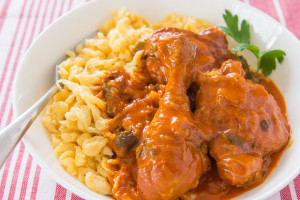
With just a handful of ingredients, Chicken Paprikash, or Paprika Chicken is a simple delicous Hungarian stew.
My husband is an excellent cook of Hungarian foods. Following is his personal recipe for Paprika Chicken, a very refined version of this classic dish. Serve accompanied by egg noodles, plain rice, or boiled potatoes. In Hungary, this dish is traditionally served with small egg dumplings called galuska.
3 tablespoons corn oil*
2 tablespoons butter*
2-1/2 to 3-pound chicken, cut into serving pieces
2 medium onions, chopped
3 large cloves garlic, minced
1 rounded tablespoon medium-hot paprika
2 tablespoons hot paprika
2 rounded tablespoons mild paprika
2 tablespoons brandy
3/4 cup chicken stock
1/3 to cup sour cream
Salt to taste
*(Or substitute a total of 5 tablespoons lard or rendered goose fat, for the entire recipe.)
Heat the oil and butter (or lard/goose fat) in a large (4- to 6-quart) heavy stove-top casserole. Brown the chicken pieces over medium-high heat. Using a slotted spoon, remove the chicken and set aside. Add the chopped onions to the casserole and saute the onions until translucent. Add the garlic and cook for 1 to 2 minutes. Reduce heat to very low, stir in all the paprika, and cook for an additional minute, stirring constantly. Add brandy; stir to deglaze the pan. Add the browned chicken pieces and mix well. Add the chicken stock and stir.
Bring the mixture to a boil over high heat, reduce heat to low, cover and simmer for 45 to 60 minutes. Using a slotted spoon, remove the chicken to a serving platter and keep warm. Bring the liquid in the casserole to a boil over high heat, and reduce the liquid by about one-third. Turn the heat to low, and slowly stir in the sour cream, until the sauce is smooth. Add salt to taste. Pour the sauce over the chicken and serve immediately.
Yield: 6 servings
Heat Scale: Medium
Green Beans with Paprika
This sinfully rich dish is typical of the way that vegetables were prepared in the past, before anyone cared about cholesterol. Serve these creamy beans as an accompaniment to simple roasted meats.
1/4 cup (4 tablespoons) butter or lard
1 medium onion, finely chopped
2 teaspoons mild Hungarian paprika (or 1 teaspoon each mild and hot paprika)
1 pound fresh green beans, cut diagonally into 1- 1/2-inch slices
2/3 cup water
1/2 teaspoon salt
1/2 cup pure sour cream (containing no additives)
1 tablespoon flour
Heat the butter or lard in a large saucepan and sauté the onion until golden. Sprinkle paprika over the onion and stir to mix well. Add the green beans and stir until all the pieces are coated with paprika. Stir in water and salt. Bring the liquid to a boil over high heat, reduce the heat to low, cover the pan tightly, and simmer for 20 to 30 minutes, until beans are tender. In a small bowl, whisk together the sour cream and flour until mixture is smooth. Stir the sour cream into beans and simmer, uncovered, 5 minutes longer. Serve hot.
Yield: 3 to 4 servings
Heat Scale: Mild
Paprika Mushrooms
In Hungary, this dish is served over toasted bread or rolls, or accompanied by dumplings or plain rice. It can also be a rich side dish to accompany roasted chicken or pork. To save preparation time, slice the mushrooms with an egg slicer.
1/2 cup (8 tablespoons) butter or lard
2 medium onions, chopped
1 pound fresh mushrooms (champignons, or a mixture of several kinds of mushrooms), cleaned and thinly sliced
1 large garlic clove, minced
1 rounded tablespoon Hungarian mild or medium-hot paprika
1/2 teaspoon salt
1 cup pure sour cream (containing no additives)
Melt the butter or lard in a large skillet over medium-high heat. Add the onions and sauté until they are translucent. Add the mushrooms and garlic, stirring until they are well-coated with the melted fat. Reduce the heat to very low, sprinkle the paprika over the ingredients in the skillet, and stir to mix well. Increase the heat to medium and bring the mixture to a simmer. Cover the skillet and simmer for about 10 minutes, or until the mushrooms begin to turn soft. Stir in the salt and sour cream. Cook, stirring constantly, over low heat for 1 to 2 minutes longer, just until the sour cream is warm. Do not let the mixture boil. Serve immediately.
Yield: 4 large or 6 medium-size servings
Heat Scale: Mild









